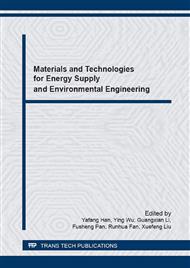[1]
Dharani Sabba, Shweta Agarwala, et al. A maskless synthesis of TiO2-nanofiber-based hierarchical structures for solid-state dye-sensitized solar cells with improved performance [J]. Nanoscale Research Letters, 2014, 9(1): 1-9.
DOI: 10.1186/1556-276x-9-14
Google Scholar
[2]
TENG Letian, ZHAO Kang, TANG Yufei. Photocatalytic Acticity of TiO2 Nanofibres Prepared via Electrospinning Technology [J]. JOURNAL OF THE CHINESE CERAMIC SOCIETY, 2012, 40(8): 1215-1219.
Google Scholar
[3]
FORMO E, LEE E, DEAN C D, et al. Functionalizetion of electrospun TiO2 nanofibers with Pt nanoparticles and nanowires for catalytic applications [J]. Nano Lett, 2008, 8(2): 667-673.
Google Scholar
[4]
Hoda S H. Synthesis of highly-active single-crystalline TiO2 nanorods and its application in environmental photo-catalysis [J]. Materials Letters, 2009, 63: 1471-1474.
DOI: 10.1016/j.matlet.2009.03.057
Google Scholar
[5]
Zhang J L, Wu Y M, et al. Development of modified N doped TiO2 photocatalyst with metals, non-metals and metal oxides [J]. Energy and Environmental Science, 2010, (3): 715-726.
DOI: 10.1039/b927575d
Google Scholar
[6]
Tekmen C, Suslu A, et al. Titania nanofibers prepared by electrospinning [J]. Materials Letters, 2008, (62): 4470-4472.
DOI: 10.1016/j.matlet.2008.08.002
Google Scholar
[7]
Sigmund W, Yuh J, Park H, et al. Processing and structure relationships in electrospinning of ceramic fiber systems [J]. Journal of the American Ceramic Society, 2006, 89(2): 395-407.
DOI: 10.1111/j.1551-2916.2005.00807.x
Google Scholar
[8]
Ghang J L,Wu Y M, Xing M Y,et al. Development of modified N doped TiO2 photocatalyst with metals, non-metals and metal oxides [J]. Energy and Environmental Science, 2010, (3): 715-726.
DOI: 10.1039/b927575d
Google Scholar
[9]
Chandrasekar R,Zhang L F, Howe J Y,et al. Fabrication and characterization of electrospun titania nanofibers [J]. J Mater Sci, 2009, 44: 1198-1205.
DOI: 10.1007/s10853-008-3201-1
Google Scholar
[10]
Chen J Y, Chen H C, Lin J N, et al. Effects of polymer media on electrospun mesoporous titania nanofibers [J]. Materials Chemishy and Physics, 2008, 107(2-3): 480-487.
DOI: 10.1016/j.matchemphys.2007.08.018
Google Scholar
[11]
Yejun Qiu, Jie Yu, et al. Synthesis of porous NiO and ZnO submicro- and nanofibers from electrospun polymer fiber templates [J]. Nanoscale Research Letters. 2009, 4(2): 173-177.
DOI: 10.1007/s11671-008-9221-6
Google Scholar
[12]
Gil-Tae Kim, Jun-Seok Lee, et al. Investigation of pore formation for polystyrene electrospun fiber: Effect of relative humidity [J]. Korean Journal of Chemical Engineering. 2005, 22(5): 783-788.
DOI: 10.1007/bf02705799
Google Scholar
[13]
Sei-Hyun Lee; Seok-Min Yun; Sang Jin Kim; Soo-Jin Park; Young-Seak Lee. Characterization of nanoporous β-SiC fiber complex prepared by electrospinning and carbothermal reduction [J]. Research on Chemical Intermediates 2010, 36(6-7): 731-742.
DOI: 10.1007/s11164-010-0175-9
Google Scholar
[14]
Mukai S R, Nishihara H, Shichi S, et al. Preparation of porous TiO2 cryogel fibers through unidirectional freezing of hydrogel followed by freeze-drying [J]. Chem. Mater., 2004, 16(24): 4987-4991.
DOI: 10.1021/cm0491328
Google Scholar
[15]
Madhugiri S, Sun B, Smirniotis P G, et al. Electrospun mesoporous titanium dioxide fibers [J]. Microporous and Mesoporons Materials, 2004, 69(1-2): 77-83.
DOI: 10.1016/j.micromeso.2003.12.023
Google Scholar
[16]
Lim J, Yi G, Moon J H, et al. Superhydrophobic films of electrospun fibers with multiple-scale surface morphology [J]. Langmuir, 2007, 23(15): 7981-7989.
DOI: 10.1021/la700392w
Google Scholar
[17]
Zhan S H, Chen D R, Jiao X L, et al. Mesoporous TiO2/SiO2 composite magnifiers with selective photosynthetic properties [J]. Chemical Communications, 2007, (20): 2043-(2045).
DOI: 10.1039/b618905a
Google Scholar
[18]
Li D, Xia Y. Rapid fabrication of titania nanofibers by electrospinning [C] /San Diego, CA, United States: The International Society for Optical Engineering, (2003).
Google Scholar
[19]
Kanehata M, Ding B, Shiratori S. Nanoporous ultra-high specific surface inorganic fibres [J]. Nanotechnology, 2007, 18(31): 315602.
DOI: 10.1088/0957-4484/18/31/315602
Google Scholar


